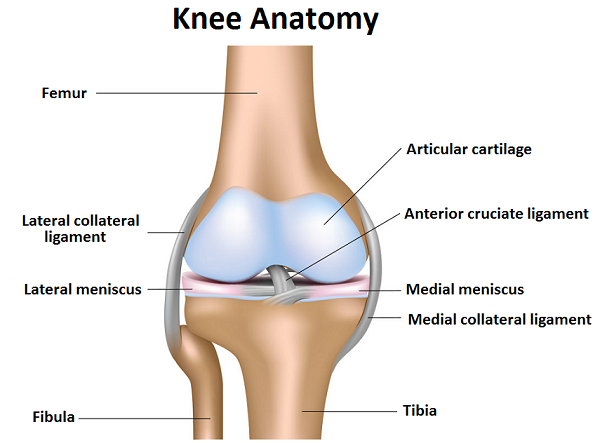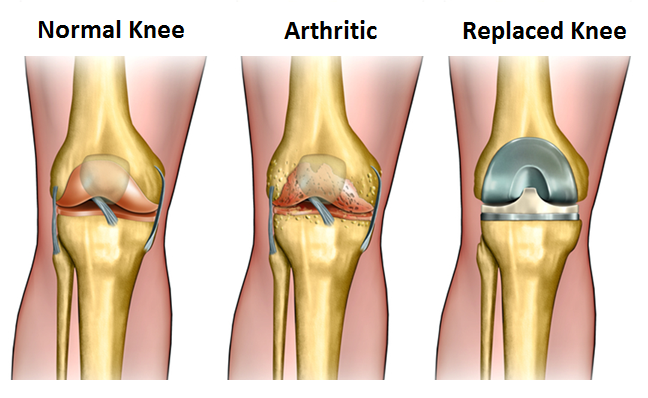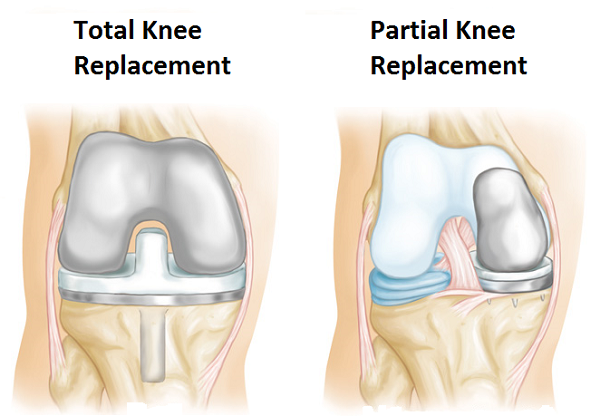Knee replacement surgery, medically termed as Arthroplasty, is one of the most performed surgical procedures in India. Thanks to the growing population of people suffering from arthritis and osteoporosis that damage knee joints to an extent, when only Knee replacement surgeries can serve as an effective remedy!
Joints in body are nothing but areas where two or more bones meet, and are held together with muscles, tendons and ligaments. Most of the bone joints are movable. Knee joints for example are movable; meaning, that bones are not completely rigid and are allowed to move, providing the needed flexibility. Thus, when knee joints are damaged, your locomotory activities get restricted.
What is Knee Replacement Surgery?
Knee replacement surgery involves replacing damaged parts of the knee with artificial metal and plastic components to eliminate problems of excessive pain and restricted movement.
Knowing about Knee anatomy is important to accurately understand the causes of damaged knee and types of surgical options. The knee has the following components:
- Knees have two bones – Shin bone (Tibia) or the largest bone of lower leg. And Femur that forms the thigh bone of upper leg. Both these bones are protected by the knee cap.
- Cartilages – Two bones are cushioned with different types of cartilages. Hyaline cartilage protects the ends of your bones. Meniscal cartilage behaves as a shock absorber and spreads the entire load on knees uniformly. When these cartilages get damaged due to variety of reasons, the knee joints are exposed, leading to pain and thus demand for surgical treatments at later stages.
- Synovial Membrane – A membrane lining the joint and secreting synovial fluid that lubricates joints and eliminates friction.
- Ligaments – A tough supportive tissue supporting the joint and limiting unnecessary joint movements.
- Tendons – Tissues that connect bones to the muscles.
A damage or a disease to any of the above mentioned components require knee replacement surgery when all other remedial measures fail to serve expected results.
Who needs a knee replacement surgery?
Knee replacement surgery is an ultimate solution, and is only opted when all other procedures have failed to bring about the needed relief. There can be various reasons when knee replacement surgeries can be opted for. The following are some of the physical ailments and conditions, if left untreated, make knee replacement surgery an inevitable procedure:
Osteoarthritis: A very common health condition among the older population; especially, females. It is a condition, leading to gradual loss of cartilages protecting the bones. In the absence of cartilages, the bones rub against each other, resulting in unbearable pain. Initial treatments can resolve the condition slightly. However, if treatment is delayed, surgery could be the only possible solution.
Rheumatoid arthritis: A condition where the membrane protecting the knee joint thickens and is inflamed; posing excessive pressure on cartilages that gradually start thinning. Surgical solution is considered to be the best option for this condition.
Trauma: A variety of situations such as road accidents or anything else leading to severe knee injury can be treated with knee replacement surgery.
Therefore, if you are suffering from these above medical conditions, opting for diagnostic tests such as X rays, physical exams and screening tests is highly recommended to prevent further aggravation. Thus, you can save yourself from undergoing arthroplasty.
Who cannot opt for a knee replacement surgery?
Although, most people are eligible to undergo a knee replacement surgery; there are a few conditions which do not allow the surgical treatment. Let’s see a few of those:
- Weak thigh bones: People with very weak and thin thigh bones cannot opt for knee replacement surgery, as the bones will not be able to hold the artificial joint, leading to greater complications.
- Ulcers: Sometimes, the skin under your knees may have underlying ulcers that mostly remain undiagnosed for long. People with such conditions cannot opt for replacement surgery as these may lead to severe infections.
Types of Knee Replacement Surgery:
There are two types of Knee Replacement Surgery:
- Total Knee Replacement Surgery
- Partial Knee Replacement Surgery
Total Knee Replacement Surgery:
Total Knee Replacement Surgery (TKR) is more commonly performed as compared to the other form of treatment. The surgical method involves removal of both sides of knee joints, some parts of bones along with damaged cartilages.
The procedure involves removing the end part of thigh bone and shin bone; along with their damaged cartilages. The thigh bone is replaced with metal components, whereas the shin bone is replaced with plastic parts. Sometimes, your knee cap may also receive a plastic surfacing to eliminate severe pain and discomfort.
Partial Knee Replacement Surgery:
Knee can be divided into three parts – medial or inner, outer or lateral and the kneecap. If only a part of your knee is affected, then partial knee replacement surgery can be carried out. The procedure involves removing only the damaged part while keeping bones and healthy cartilages or ligaments intact.
Not all can undergo partial surgeries. Patients with very strong ligaments can only take up this surgery. If you have weak ligaments, half surgeries cannot be opted even when a single knee compartment is affected. Many complications may arise while undergoing partial knee replacement surgery.
Partial or half knee replacement surgeries involve smaller incisions leading to shorter recovery time. However, these are more complex procedures as compared to TKR and do not guarantee a life long result.
Knee Cap replacement:
Besides the two types of surgeries, kneecap replacement is also an effective alternative. A procedure that only removes the underlying surface of knee cap and a part of the groove.
The procedure can be opted if the entire knee joint is not damaged and the medical condition that is causing the problem is expected to remain stagnant. However, if disease progression is suspected or takes place, Knee cap fails to deliver the expected result.
How to prepare for a Knee Replacement Surgery?
Knee replacement surgery is a major operation to undergo. Therefore, if you or anyone from your family is scheduled for an operation, these preparatory guidelines need to be followed before the procedure:
- Upper body exercises: Patients are asked to use crutches and supports post surgery. Therefore, maintaining your upper body in good form is vital. If you do not have that necessary strength, you will not be in a position to use crutches effectively and thus slowing down the recovery rate. Talk to your doctor who could suggest you with certain exercises that can help you strengthen your upper body and maintain you in good form.
- Restrain from smoking: Smoking is excessively damaging for our mental and physical wellbeing. And when it comes at recovering from major surgeries such as this, smoking could stagnate the recovery for long durations. It needs to be noted that quitting to smoke after the procedure will not be sufficient to guarantee speedy recovery. Therefore, quit it much before you are scheduled for the operation.
- Control weight gain: Excessive weight may make your new knee joints a little unstable. Therefore, make efforts of restricting fatty food intake so that it will not add to your body weight.
- Enlist your health information – Medicines, other ailments, allergies or anything else that is somehow related to your overall health. Before the procedure, you would be required to share these pieces of information very often. So, stay prepared.
- Follow the doctor’s advise: It is very much important that you follow every word advised by your doctor. You may be advised to eliminate the use of few medicines leading to excessive bleeding. So, do not fail to follow these important instructions.
What happens during and after the procedure?
The entire knee replacement surgery takes around 1 – 2 hours, where the patient is completely under general anesthesia. The surgeon then makes incisions depending on the type of surgery you are going through and replaces the damaged cartilages, ligaments and tissues with metal and plastic fittings. A plastic spacer is also placed between the metal components to facilitate smooth movement.
Patients are mostly required to spend a few nights in the hospital post surgery. During these days, the doctor will closely observe your response to the treatment and will allow you to reach home at a suitable time.
Taking Care Post Surgery:
- Slowly start moving your legs as this will guarantee sufficient blood flow and will also help in reducing swelling
- Walking around with crutches will be easy and equally necessary; however, bathing, cooking or household chores would require help for at least 3 to 6 weeks. Bathing sitting on a chair and having someone to cook is suggested.
- Never skip exercises recommended by your surgeon to guarantee quick recovery. Undergoing physiotherapy for minimum two months post surgery is highly recommended.
- Prevent blood clot formation with thinners. Patients are very much susceptible at developing blood clots post surgery which prove detrimental to your health. Therefore, making efforts such as taking regular blood thinners and simple toe and ankle exercises can help prevent blood clots.
Rare complications that may arise:
Knee replacement surgeries have highest success rates and do not show complications if proper post operative guidelines are followed. However still, if you do experience any of the below mentioned problems, call for your doctor immediately:
- Persistent pain that worsens with time
- Continuous and heavy bleeding
- Blood clots that may or may not be painful. Sometimes, you may experience shortening of breadth.
- Infection leading to multiple problems that are not very intense in the beginning. Antibiotics are sufficient for controlling infections if diagnosed at an early stage.
- Numbness in the surrounding area
- Restricted movement or stiffness – Ideally your knee should bend sufficiently within a few days of time. If this is not observed, you will definitely have to visit your doctor.
- Inequality of leg length. This is a rare condition and can be corrected.
This was all about knee replacement surgery and what to expect from it. Owing to its great demand, arthroplasty procedure is undergoing enhancement very rapidly. Newer techniques are continuously implemented to ease the procedure and shorten recovery period.
However, at the end of the day, it is our own lifestyle that impacts overall health and our response to any treatment. Therefore, preparing well before the procedure and taking care post surgery are the two important factors that govern outcomes of knee replacement surgeries. Thus, now that you have read the entire blog, you are perhaps in a position to drive best outcome from the surgery. So wishing you a quick and happy recovery, we conclude today’s post!





Excel spine clinic sec 7 delhi